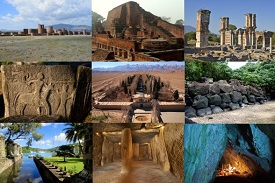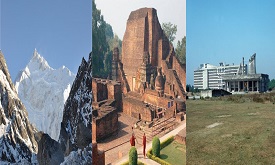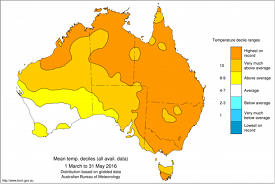
- Current Affairs July 2016
- Current Affairs - Home
- July 2016 - Summary
- Appointments
- Awards
- Deaths
- Defence
- Economic
- Environment
- Banking
- Important Days
- International
- Miscellaneous
- National
- Persons in NEWS
- Places in NEWS
- Regional
- Reports
- Resignations & Retirements
- Sports
- Science & Technology
- Various Committees
- Books & Authors
- July 2016 - Exams Resources
- Current Affairs - Quiz
- Current Affairs - Test
- Current Affairs - PDF
Current Affairs July 2016 - Environment
News 1 - Study reveals that the Ozone layer in Antarctic is healing

Scientists say they have found the first clear evidence that the thinning ozone layer over the Antarctic is starting to heal. The hole was around 4 million sq. km smaller than it was in the year 2000 - an area roughly the size of India.
The study attributed the ozone’s recovery to the “continuing decline of atmospheric chlorine originating from chlorofluorocarbons (CFCs)”. Most of the world signed on to the Montreal Protocol in 1987, which banned the use of CFCs.
News 2 - The Bornean Orangutan listed under the Critically Endangered Animals

The International Union for Conservation of Nature (IUCN) announced that the Bornean Orangutan as a Critically Endangered Animal due to various reasons like habitat loss, habitat degradation and illegal hunting. It has been observed that every year 2000 to 3000 orangutans have been killed by hunters or villagers, as a result, there will be further 22% decline in forthcoming years from 2010 to 2025.
Recently, the Whale Shark, the largest fish in the world, was also put by IUCN on the endangered list.
News 3 - Rare Marbled Map butterfly sighted in the Eastern Ghats

A Rare Marbled Map Butterfly was sighted by a group of green enthusiasts including N. Chandramohan Reddy, an Indian Forest Service officer, in Eastern Ghats near PM Kota village of Maredumilli Mandal in the East Godavari district of Andhra Pradesh. This is the first time that the Marbled Map butterfly species, usually found in the North-East, was sighted in South India.
The Marbled Map (Cyrestis cocles) is listed as a rare butterfly species. Its availability is confined to the forested hills in the region between Sikkim and Arunachal Pradesh, Jharkhand, Bhutan and Myanmar.
News 4 - UNESCO declared Nalanda Mahavihara as the 33rd World Heritage Site in India

Nalanda Mahavihara which is situated 98 kms away from Patna has been announced as a World Heritage Site by UNESCO. This would be the second UNESCO heritage site after Mahabodhi temple in Bodh Gaya. The ruins of ancient Nalanda Mahavihara known as old Nalanda University of Bihar got inscribed as a World Heritage Site by UNESCO.
The ruins include the archaeological remains of monastic and scholastic institutions dating from the 3rd century BC to the 13th century AD. The ancient Nalanda University was a major Mahavihara or a large Buddhist monastery that also doubled up as a knowledge resource centre from the 5th to 1200 AD in the kingdom of Magadh.
News 5 - Nine new World Heritage Sites included by UNESCO

The 40th session of the World Heritage Committee meeting held in Istanbul, Turkey decided to add nine new sites on its World Heritage List, thus making a total of 981 heritage sites both cultural and natural till date.
The nine new World Heritage Sites are:
- The ancient city of Ani
- Nalanda (The Oldest University in The World)
- Ancient Site of Philippi (Greece)
- Stecci Medieval Tombstones Graveyards
- The Persian Qanat, Iran
- Nan Madol (Ancient Ceremonial Centre)
- Antequera Dolmens (Spain)
- Antigua Naval Dockyard and Related Archaeological Sites
- Gorham’s Cave Complex (United Kingdom and Northern Ireland)
News 6 - India’s Chandigarh and Sikkim's National Park now on the UNESCO list

Sikkim’s Khangchendzonga National Park and Chandigarh’s Capitol Complex are included in UNESCO’s world heritage site list. It was announced at the 40th session of the WHC meeting held at Istanbul in Turkey. The KNP is the first ‘mixed’ category heritage site listed from India to UNESCO list as it possesses qualities of both natural and cultural significance.
Chandigarh’s Capitol Complex which comprises the Legislative Assembly, Secretariat and High Court, was designed by French Architect Le Corbusier in 1950 when the city was being developed as a symbol of independent, modern India. India now has 35 sites overall on the list of UNESCO including 27 cultural properties, seven natural sites and one mixed site listed as World Heritage Sites.
News 7 - WMO warns that 2016 is set to be the World's Hottest Year on Record

The World Meteorological Organisation (WMO) announced that 2016 is on the track to be the world's hottest year on record after global temperatures for the first six months of 2016 broke many records. The average temperature in the first six months of 2016 was 1.3°C (2.4°F) warmer than the preindustrial era in the late 19th century, according to NASA. Carbon dioxide levels, which are driving global warming, have reached new highs.
Two separate reports from the U.S. National Oceanic and Atmospheric Administration and NASA's Goddard Institute for Space Studies (NASA GISS) both highlighted the dramatic and sweeping changes in the state of the climate.
To Continue Learning Please Login